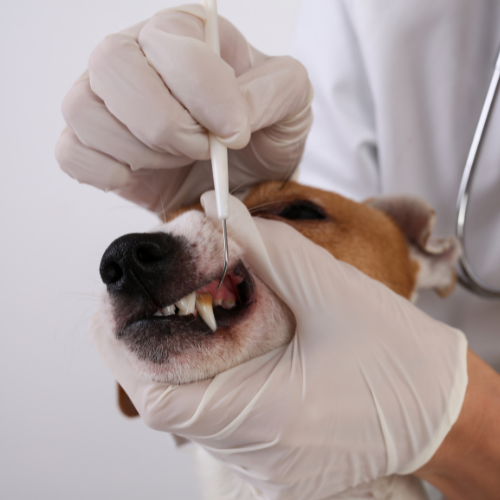Dental Disease
Why is dental care important?
Recent studies indicate 70% of adult cats and 80% of adult dogs show symptoms of oral disease by the time they are 3 years old! Just like humans, we only have one set of adult teeth for life so it is important that we look after them. If you’ve ever had a toothache, then you will understand that dental disease is painful! Just because your pet eats, doesn’t necessarily mean they are not in pain.
Worse still, dental disease is related to systemic disease! When a pet develops dental disease, significant quantities of bacteria reside within the mouth and the oral tissues. These bacteria can enter the bloodstream and travel to other areas within the body, causing distant or systemic effects. There are three organs that are especially susceptible to the spread of oral bacteria: heart, liver, and kidneys. The bacteria associated with infection and inflammation of the heart’s inner lining (endocarditis) are often the same as the bacteria found within the mouth of pets with dental disease. The liver and kidneys are particularly susceptible as they are responsible for filtering the blood, which allows bacteria from the mouth to easily spread to these organs.

Common signs of dental disease
- Bad breath
- Plaque build-up
- Excessive drooling or licking
- Sore or bleeding gums when eating or chewing
- Decreased appetite
- Gingivitis/inflammation of the gums
- Issues with chewing
- Pawing at mouth
Dental grading
When you bring your pet in for a consultation, an oral exam is one component of a thorough physical examination. Your vet will often grade your pet’s teeth between 0 to 4. Just because a dental grade 3 and 4 exists, does NOT mean we wait until then to intervene when your pet already has severe dental disease. Dental care is all about PREVENTATIVE CARE! Dental grade 1 and 2 is the best time to be proactive as this is when the effects of dental disease can still be reversed.

Dental care at home
Just like humans, a significant component of preventative dental care can be performed at home.
- Regular brushing at home
This is by far the MOST beneficial at-home management option when it comes to dental care. Plaque is a sticky film of bacteria that forms on the surface of the teeth within a few hours of eating food. Within 24 hours, that plaque can eventually harden to form tartar. Tartar along the gum line allows for bacteria to grow and multiply, leading to inflammation of the gums (gingivitis) and disease of the underlying tissues and bones that hold teeth in their place (periodontal disease). If you can, you should brush your pet’s teeth as often as we do – everyday! - Dental care prescription diet
If your pet has no dietary restrictions and not a particularly fussy eater, then a convenient management option – since your pet has to eat everyday – is to feed a dental care prescription diet like Hill’s Prescription diet Dental care t/d. The kibble is designed in a special size, shape and matrix that helps to remove plaque. It is most beneficial if fed exclusively as your pet’s diet. - Dental chews and treats, water additives & powder, gels, sprays
Not all dental chews, treats and powders are created equal and some might simply just be a glorified snack for your pet with no actual dental care benefits. One of the best ways to assess the quality of a dental care product is to look at the Veterinary Oral Health Council (VOHC) list of approved products. These products do not replace regular brushing at home, but are certainly better than nothing – think of chewing gum or rinsing with mouthwash!
Dental scale and polish
Ask any veterinary dental specialist, the average cat or dog ideally needs a dental scale and polish every 12 months – just like humans! We perform dental scale and polish procedures, with dental x-rays, on a routine basis and can also perform tooth extractions, if necessary. While dental care at home is indispensable, a regular dental scale and polish is still necessary to keep your pet’s teeth sparkling white, clean and healthy! As humans, we get a dental scale and polish pretty regularly, despite us brushing our teeth every day and your pet is no different! The procedure is a lot more common than you might think! A dental scale and polish procedure is the only way to remove tartar build-up on your pet’s teeth, clean under the gumline (subgingival space) and to assess what is going on under the gum line with dental x-rays. We not only make the teeth look fantastic by scaling all that gunk off, we also check the gums thoroughly to make sure there are no problems brewing under the radar that would otherwise be missed on a conscious oral exam.


